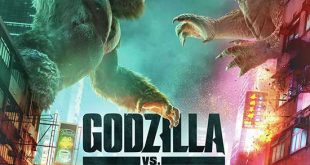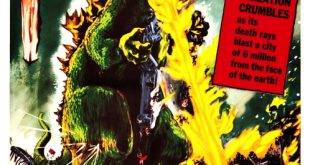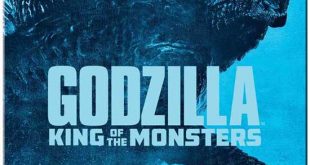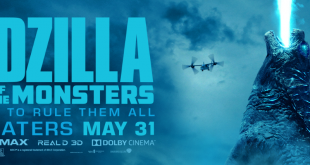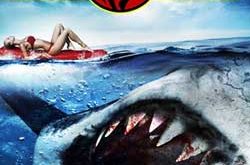Giant monsters, the halls of horror are full of them. The most famous of these monsters are King Kong (1933) and Godzilla (1954), each spawning countless imitations. King Kong came first in the Thirties directed by Merian C. Cooper and Ernest B. Schoedsack, with classic special effects by Willis O’Brian. A sequel follows later the same year with The Son of Kong (1933) and two remakes have been made – King Kong (1976) directed by John Guillermin and King Kong (2005) directed by Peter Jackson. Kong would even meet Godzilla in Toho’s King Kong vs. Godzilla (1962) and star in a sequel for Toho called King Kong Escapes (1967). Their meeting occurs nearly a decade after the premiere of Godzilla (1954), which produced a long running series of giant monster movies with a U.S. version rumored for the near future. These films introduce creatures such as Mothra, Varan, Ghidorah and Mechagodzilla. The closest to these two might be Gamera, a giant space turtle. Throughout the Sixties and Seventies, a wide variety of challengers to the throne would invade Saturday matinees and Drive-In theaters across the world. Here are a few of the more unusual giant monsters to make it to the big screen.
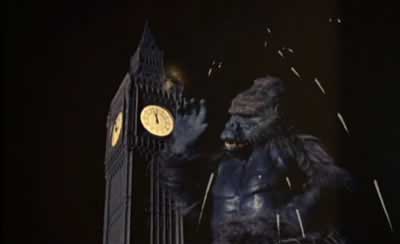
KONGA 1961
In John Lemont’s science fiction film, Konga, British Botanist Charles (Michael Gough) Decker subjects a young chimpanzee to a serum that transforms it into a giant murderous gorilla. After King Kong (1933), Son of Kong (1933) and Mighty Joe Young (1949), most movie gorillas remained an actor in a suit rather that the stop motion effects that made these classic so great. Konga also employs the man-in-suit ideals, but this time the gorilla grows to be larger than a two-story house and picks up Dr. Decker much like King Kong carries around Ann Darrow. Years later, Dino De Laurentiis’ version of King Kong (1976), directed by John Guillermin, again employs the man-in-suit monster with costume effects created by the legendary Rick Baker. Even with superior effects and improved set design, it’s still visibly a man-in-suit and works no better than the lower budget feature Konga 15 years prior.

GORGO 1961
The same year, Gorgo, another British entry into the giant monster movie genre, was released. Directed by Eugene Lourie, the film tells the story of a large reptilian monster – 65 feet tall – discovered off the coast of Ireland. The creature is brought to London to be studied. When scientists examine the creature, named Gorgo, they determine that he is still a child and that an adult version would be 200 feet tall. Soon they discover that Gorgo’s mother is following a destructive path to her son. Arriving in London, the monster destroys Tower Bridge and Big Ben and faces off with tanks, infantry and the Royal Air Force. Gorgo ends up being a cross between The Beast from 20,000 Fathoms (1953) and Godzilla (1954).
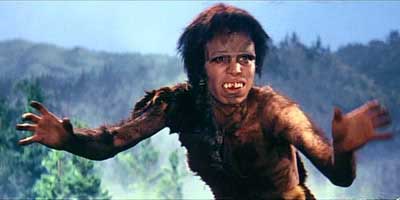
FRANKENSTEIN CONQUERS THE WORLD 1965
Ishiro Honda and Toho Pictures, internationally known for their Godzilla franchise, play around with the Frankenstein legend in the Sixties with Frankenstein Conquers the World, turning him into a kaiju monster. The story begins during World War II with Nazis stealing the heart of the Frankenstein Monster and taking it to Hiroshima for experimentation. Shortly after, the Allied Forces drop the bomb and the heart is lost. Years later, a savage child is found scavenging the streets of Hiroshima and is brought to the attention of American scientist, Dr. James Bowen (Nick Adams). A former Naval Captain, Kawai – who brought the heart to Japan, explains that the boy must have grown from heart of the Frankenstein Monster. The boy monster grows to enormous size and escapes to the country side. Meanwhile another monster, Baragon, escapes from a cavern below the earth and begins terrorizing the villagers. Ending, of course, with the Frankenstein boy encountering and battling Baragon.

WAR OF THE GARGANTUAS 1966
Released in Japan as Frankenstein’s Monsters: Sanda versus Gaira, War of the Gargantuas is intended to be a sequel to Frankenstein Conquers the World but only makes sparse reference to the previous picture. Spawned from the cells of the previous film’s monster, the brothers Gargantua grow up separately: Gaira, the green one, lives in the sea and preys upon humans it encounters; Sanda, the brown one, lives in the Japanese Alps raised in captivity. When Gaira descends upon Tokyo, Sanda is sent to defend the city from his brother’s attacks. The Frankenstein brothers battle in the war of the gargantuas. Directed by Ishiro Honda and starring American actor Russ Tamblyn, War of the Gargantuas blends together the more humanoid monster from Frankenstein Conquers the World and the more gorilla-like monster from Godzilla vs King Kong, with the Gargantuas appearing like giant Crayola colored Yetis.
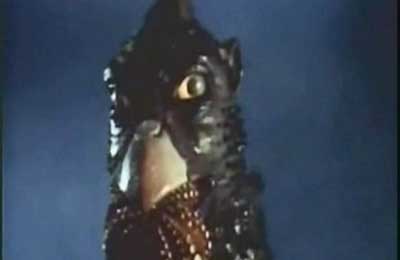
GAPPA THE TRIPHIBIAN MONSTER 1967
Also known as Monster from a Prehistoric Planet, Gappa the Triphibian Monster was produced by Nikkatsu Corporation to compete with the successful Toho studio and their vast library of kaiju films. The plot of Gappa is very similar to that of Gorgo years prior. An infant monster is discovered on the Polynesian Islands by explorers, captured and taken to Japan for experimentation. Soon after, the creature’s parents rise up and attack Japan searching for their captive offspring. This time the monster is an odd combination of Godzilla and Rodan as a bird-lizard, complete with wings, beak and fierce breath rays.
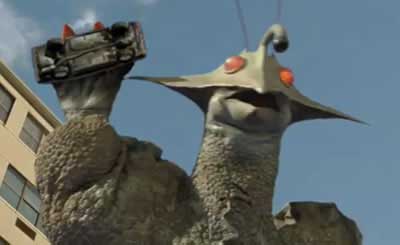
THE X FROM OUTER SPACE 1967
Another studio hoping to cash in on Toho’s kaiju success, Shochiku Kinema Kenkyu-jo, releases The X from Outer Space the same year. X, also known as Guilala, develops from spores brought to Earth from Mars. As a fully formed monster, Guilala looks like a giant chicken-lizard, spitting fireballs and munching on nuclear energy. The silly looking creature is finally defeated and the spores that created him are sent to orbit the sun for eternity. The creature returns in a sequel that’s more of a sendup or satire in 2008 with the comedic feature The Monster X Strikes Back/Attack the G8 Summit where he ends up fighting a giant animated golden warrior statue that resembles (and is portrayed by) actor Takeshi Kitano.
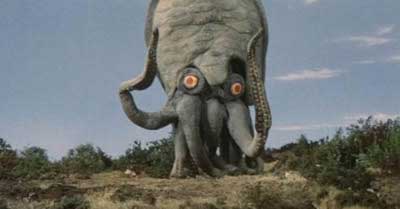
SPACE AMOEBA 1970
Toho Studios attempts to create another kaiju franchise with Space Amoeba, also known as Yog – Monster from Space. The film features a variety of monsters, one of which is Gazora who resembles a mutated giant squid. In the plot, a space probe returns to Earth carrying a interstellar stowaway: Yog, a being of pure energy. The alien crash lands in the South Pacific and possesses the body of a giant cuttlefish, mutating it into Gazora. After attacking a nearby island, the inhabitants realize the monster’s weakness is fire. When the creature is fatally burned, Yog leaves the monster to die and moves on to other hosts, including a gigantic stone crab, Ganime, and an ordinary turtle, Kamoebas. Each of the kaiju is imaginative and inventive with Gazora being the most memorable.

GODZILLA vs HEDORA 1971
Godzilla, throughout the years, has faced a variety of strange, wondrous and sometimes wacky monsters: giant spiders (Kumonga), giant shrimp (Ebirah) and praying mantises (Kamacuras). In Godzilla vs. Hedora, he faces his most bizarre opponent with Hedora, the Smog Monster, a foe that rivals in strength to that of King Ghidorah, Mechagodzilla and, later, Destroyah. Originating from a cloud of spore falling from space, Hedora is born as the spawned organisms begin to feed on sludge, smog and other man-made pollutants. Taking many shapes as he grows from a spore creature, Hedora become a giant monster of living sludge and is able to take many forms. For traveling in the ocean, it resembles a tadpole; for walking on land, it forms into a four-legged pile of sludge; for flying, it looks like a round bat; and to battle Godzilla, it takes a humanoid shape.

For the remainder of the Seventies studios continue to produce giant monster after giant monster as Toho’s Godzilla franchise degenerates into childish, kiddie productions. Tsuburaya Productions unleash a little seen challenger to Toho’s throne with Daigoro vs Goliath (1972) and Shaw Brothers Studio release another man in a gorilla suit movie titled The Mighty Peking Man (1977) after the release of Dino De Laurentiis’ King Kong (1976). A*P*E (1976) is another such feature with a famous scene of the titular giant gorilla fighting off a giant shark. Throughout the Eighties and Nineties, Godzilla would have a successful series of features returning to the big screen, as would Mothra and Gamera. In the 2000’s, famed director, Peter Jackson, resurrects King Kong (2005) for a spectacular CGI version, Korea succeeds with the hit, The Host (2006) and Matt Reeves directs the block buster release Cloverfield (2008), each keeping the notion of the giant monster movie alive as does the continued rumors of Godzilla’s return to the theaters in the near future.
 Horror News | HNN Official Site | Horror Movies,Trailers, Reviews
Horror News | HNN Official Site | Horror Movies,Trailers, Reviews
